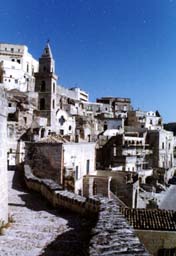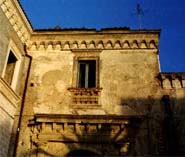|
|
|
ARC BOUTANT Historic Preservation Program |
|
|
|
SITE HISTORY:
The significance of the "Sassi" of Matera was reified in December 1993 when UNESCO placed the site on the World Heritage List. This classification recognized the sassi as a place of continuous human habitation for at least 350,000 years, dating back to the Paleolithic era. Also noted was the harmonious relationship achieved between human culture and the natural environment over a series of stages in human history.
|
|
 |
|
The term sassi means stones and refers to the rock-hewn structures which compose the site. These were dug into the calcareous (locally called "tufo" in Italian) walls of a deep gorge (called a "gravina") cut in a high plateau (called a "murgia"). The earliest caves used were naturally formed, but as the population of the settlement increased, natural caves were enlarged and new caves dug in the soft stone walls of the ravine. Extracted material was reused to build exterior walls and entire rooms in front of the caves. By the middle ages, caves were used both as habitations and as chapels and monasteries. Byzantine and Latin frescoes decorate walls, and ecclesiastical architectural symbols are sculpted in situ in the approximately 150 rupestral churches which remain. |
|
|
 |
|
|
|
The caves and their superstructures honeycomb the walls of the ravine. This hanging city had an intricate water collection system using channels and cisterns, little of which remains. A central spur of the murgia divides the sassi into two zones: the Sasso Caveoso to the south and the Sasso Barisano to the north, facing Bari. On this stone outcropping in the 8th century, elite Materans constructed the fortified Civita which consisted of a city wall with defensive towers, a rupestral cathedral (replaced by a Romanesque, free-stannding one), and palatial homes called palazzi. |
|
|
 |
An increasing peasant population and the desiccation of surrounding lands due to the clear-cutting of indigenous oak forests led to poverty within the sassi by the 19th century. Matera became the “Shame of Italy,” and in the 1950s-60s, the Italian government relocated the entire sassi population, abandoning the old town to deteriorate. A law passed in 1986 reversed the earlier forced abandonment and allowed for the rehabilitation of the sassi. The Arc Boutant Historic Preservation Program is very pleased to be invited to participate in this exciting process of conservation and revitalization of world heritage. |
|
|
 |
|
|
|
Home |
|
Courses |
|
Current Project
Publications
|
|
Contact: annetoxey@arcboutant.org
Related Links
|
|
|
|
|
|
|
|
|
|
|
|
|
|
|
|
|
|
|
|
|



